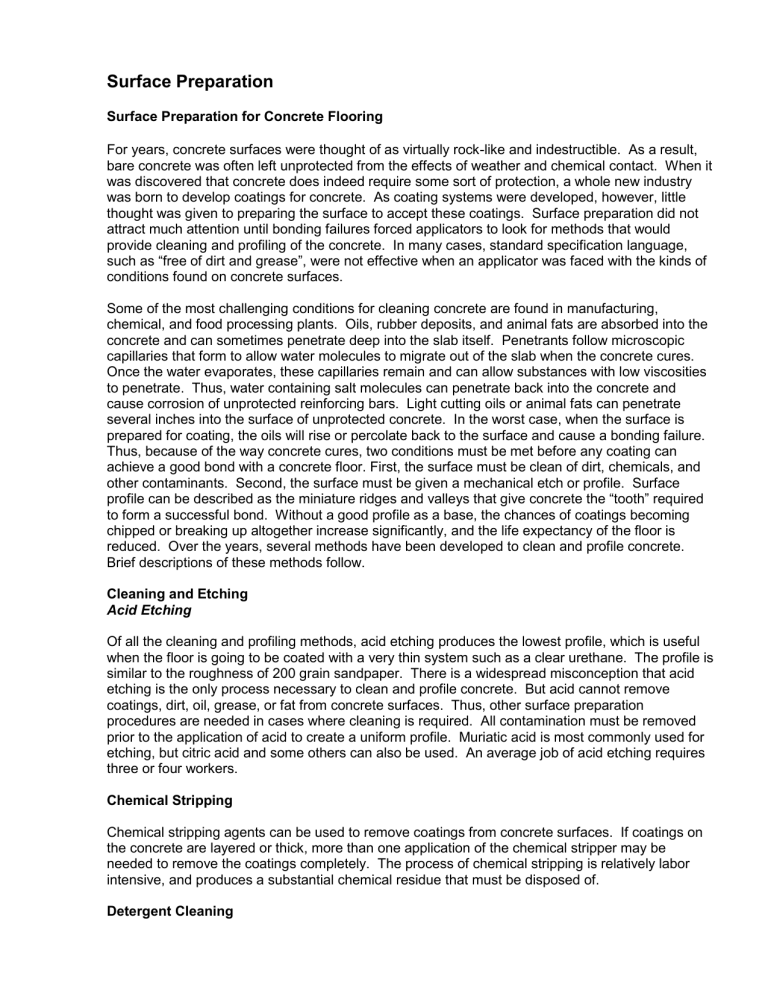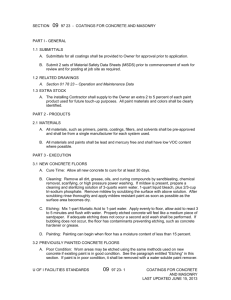Surface Preparation

Surface Preparation
Surface Preparation for Concrete Flooring
For years, concrete surfaces were thought of as virtually rock-like and indestructible. As a result, bare concrete was often left unprotected from the effects of weather and chemical contact. When it was discovered that concrete does indeed require some sort of protection, a whole new industry was born to develop coatings for concrete. As coating systems were developed, however, little thought was given to preparing the surface to accept these coatings. Surface preparation did not attract much attention until bonding failures forced applicators to look for methods that would provide cleaning and profiling of the concrete. In many cases, standard specification language, such as “free of dirt and grease”, were not effective when an applicator was faced with the kinds of conditions found on concrete surfaces.
Some of the most challenging conditions for cleaning concrete are found in manufacturing, chemical, and food processing plants. Oils, rubber deposits, and animal fats are absorbed into the concrete and can sometimes penetrate deep into the slab itself. Penetrants follow microscopic capillaries that form to allow water molecules to migrate out of the slab when the concrete cures.
Once the water evaporates, these capillaries remain and can allow substances with low viscosities to penetrate. Thus, water containing salt molecules can penetrate back into the concrete and cause corrosion of unprotected reinforcing bars. Light cutting oils or animal fats can penetrate several inches into the surface of unprotected concrete. In the worst case, when the surface is prepared for coating, the oils will rise or percolate back to the surface and cause a bonding failure.
Thus, because of the way concrete cures, two conditions must be met before any coating can achieve a good bond with a concrete floor. First, the surface must be clean of dirt, chemicals, and other contaminants. Second, the surface must be given a mechanical etch or profile. Surface profile can be described as the miniature ridges and valleys that give concrete the “tooth” required to form a successful bond. Without a good profile as a base, the chances of coatings becoming chipped or breaking up altogether increase significantly, and the life expectancy of the floor is reduced. Over the years, several methods have been developed to clean and profile concrete.
Brief descriptions of these methods follow.
Cleaning and Etching
Acid Etching
Of all the cleaning and profiling methods, acid etching produces the lowest profile, which is useful when the floor is going to be coated with a very thin system such as a clear urethane. The profile is similar to the roughness of 200 grain sandpaper. There is a widespread misconception that acid etching is the only process necessary to clean and profile concrete. But acid cannot remove coatings, dirt, oil, grease, or fat from concrete surfaces. Thus, other surface preparation procedures are needed in cases where cleaning is required. All contamination must be removed prior to the application of acid to create a uniform profile. Muriatic acid is most commonly used for etching, but citric acid and some others can also be used. An average job of acid etching requires three or four workers.
Chemical Stripping
Chemical stripping agents can be used to remove coatings from concrete surfaces. If coatings on the concrete are layered or thick, more than one application of the chemical stripper may be needed to remove the coatings completely. The process of chemical stripping is relatively labor intensive, and produces a substantial chemical residue that must be disposed of.
Detergent Cleaning
Detergents can be used to remove dirt, oil, grease, and fat from the surface of concrete.
Detergents are most commonly applied with powered floor scrubbing machines. The use of concentrated solutions results in higher detergent consumption but insures the complete removal of grease and oil, unless they have penetrated down into the concrete.
Abrasive Blasting
Conventional abrasive blasting with sand is the dirtiest method of cleaning concrete floors because of the large volume of dust that gets into the air. Equipment has to be masked completely and shielded, and the clean-up afterward is massive. Environmental restrictions will control the type of abrasive used, since some media have been linked to respiratory ailments. At the same time, however, abrasive blasting is very effective in creating a well profiled, uniform, and clean surface to which coatings can adhere well. Where there are environmental restrictions or sensitive equipment, wet abrasive blasting may be used to suppress dust. Abrasive blasting can be used to lightly abrade the surface, or it can remove the top surface of the concrete altogether.
Scabblers
Scabblers are air-powered units that utilize a number of small pneumatic hammers to pulverize the surface, thus providing an extremely rough profile for toppings and overlayments. They are very effective at breaking up delaminated toppings and, in some cases, overtrowelled or crusty concrete surfaces. Sizes of units can vary from single-hammer, hand-held units to units that are three feet wide and utilize a dozen or more hammers. Dust generated by the scabbler can be controlled by applying water to the surface; however, clean-up of the surface must be thorough. Any pulverized material or sludge left on the surface can cause a bonding failure.
Scarifying
To scarify a surface means to scratch it. Scarifying machines scratch the surface of concrete to remove dirt, coatings, grease, and sealers. Scarification is accomplished by a rotating drum, which has hardened cutters that scratch or abrade the concrete until all surface contamination is removed and sound concrete is exposed. Scarifying can achieve a profile ranging from 60 grain sandpaper to 1/8-inch grooves. Scarifiers are manufactured by a number of different companies.
Shot Blasting
Shot blasting is similar in effect to air abrasive blasting; however, the abrasive used is steel shot, which is mechanically propelled by a rotating blast wheel instead of by compressed air. The blasting process is contained within a housing, and the abrasive is recycled continuously. The pulverized concrete and contaminants are collected by dust collector units, thus providing the advantages of an abrasive-blasted surface without the massive clean-up required with open airblasting. Shot blasting can be controlled through a wide range of profiles, from light brush blasting to removal of 0.25 inch of the top surface. Control is maintained by varying the size of the abrasive, the travel speed of the unit, and the amount of abrasive thrown illustrates the relationship of the different sizes of abrasive to the profile delivered.
Shot blasting is primarily known as an all-purpose, one-step cleaning and profiling method for concrete floors. It can efficiently clean materials such as dirt, grime, old coatings, and embedded chemical contaminants. It also can be used in plants without the need for protecting sensitive equipment. Where there are not massive amounts of grease and oil on the floor, the recycled steel shot is cleaned sufficiently by the machine’s air-wash separator so that the grease and oil are not redeposited on the surface. During recycling, dust from the concrete acts as a drying agent on the
oil and grease and aids the cleaning of the abrasive. The shot-blasted surface is uniformly clean and profiled, and it readily accepts all coatings applied to it. In effect, a thin layer of the surface is blasted away, leaving essentially virgin concrete that will absorb the first coat of most systems.
The bond strength of coatings applied to shot-blasted surfaces has been measured and found to be equal to the tensile strength of the concrete to which it was applied. Labor requirements for the shot blasting units are very low, thus providing lower overall surface preparation costs. Clean-up following the blasting process usually consists of sweeping the area with a magnetic broom to pick up any loose abrasive that might have escaped the blasting unit. Shot blasting is ideally suited for preparing surfaces for epoxy toppings and most coatings. But the cleaning paths can show through clear urethanes, due to the graining effect and the overlap of succeeding passes on the concrete surface. This graining appearance, similar to what is seen when mowing grass, is produced by most mechanical surface preparation methods.
High Pressure Water Jetting
Water jetting is a recent innovation in cleaning concrete floors. Water jetting units generally use an engine-driven, piston pump to develop pressures of 15,000 to 25,000 psi. The blasting is accomplished by hand-held wands or lances, and by units that have two nozzles attached to a rotating bar. The rotary unit, which looks something like a lawn mower, is used to create a more uniform surface finish. At present, there are approximately ten manufacturers of water jetting equipment, most of which are European. Water jetting has the advantage of controlling dust in the cleaning process. While it can create a profile, it is difficult to control the profile because the high pressure water is very aggressive. In 1984, ultra-high pressure units were introduced for demolishing bridge decks and parking garages. These units are used in place of jack hammers for removing delaminated concrete and exposing reinforcing bars in slabs.
Summary
To varying degrees, all six of the surface preparation methods surveyed can provide the conditions necessary for a coating to bond successfully to a concrete floor. Those conditions include a surface free of dirt, chemicals, and other contaminants, and an adequate surface profile.
Considerations of the overall cost of each method should include materials, labor, equipment, and clean-up.






